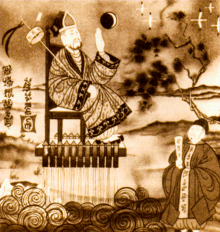Wan Hu

Wan Hu (万户 or 万虎) is a fictional Chinese official — supposedly of 2000 BC, or else the middle Ming dynasty (16th century) — who was described in 20th century sources as the world's first "astronaut" by being lifted by rockets into outer space. The crater Wan-Hoo on the far side of the Moon is named after him.
The Legend of Wan Hu
"Wang Tu"
A precursor of the story of Wan Hu appeared in an article by John Elfreth Watkins published in the October 2, 1909 issue of Scientific American, but used the name Wang Tu instead of Wan Hu:
- "Tradition asserts that the first to sacrifice himself to the problem of flying was Wang Tu, a Chinese mandarin of about 2,000 years B.C. who, having had constructed a pair of large, parallel and horizontal kites, seated himself in a chair fixed between them while forty-seven attendants each with a candle ignited forty-seven rockets placed beneath the apparatus. But the rocket under the chair exploded, burning the mandarin and so angered the Emperor that he ordered a severe paddling for Wang."
The possibly farcical text proceeds to describe several other fictional stories of ancient aviators.[1] It should be noted that a date of 2000 BC pre-dates the emergence of writing in China by three or four centuries and pre-dates the invention of gunpowder-based rockets in China by about 3,000 years.
"Wan Hu"
The legend of "Wan Hu" was widely disseminated by an unreferenced account in Rockets and Jets by American author Herbert S. Zim in 1945.[2] Another book from the same year, by George Edward Pendray, describes it as an "oft repeated tale of those early days."[3] Most authorities consider the story apocryphal.[4]
"Early in the sixteenth century, Wan decided to take advantage of China's advanced rocket and fireworks technology to launch himself into outer space. He supposedly had a chair built with forty-seven rockets attached. On the day of lift-off, Wan, splendidly attired, climbed into his rocket chair and forty seven servants lit the fuses and then hastily ran for cover. There was a huge explosion. When the smoke cleared, Wan and the chair were gone, and was said never to have been seen again."
Popular culture
- The Discovery Channel's show MythBusters attempted in the 2004 episode Episode 24 — "Ming Dynasty Astronaut" to recreate Wan Hu's flight using materials that would have been available to him. The chair exploded on the launch pad, with the crash test dummy showing what would be severe burns. An attempt was also made using a chair with modern rockets attached; however, the uncontrollable craft proved that there were far too many complications for such a thing to have succeeded. It was determined that small rockets that can be strapped to a chair cannot provide sufficient thrust to effectively lift it, giving the legend the label of myth "busted". The view the crew members had of the first test as it was performed matched what the legend said; after the smoke from the explosion had cleared, both Buster (the crash-test dummy) and the chair had disappeared, though Buster and the remains of the chair were found next to the 'launch-pad'.
- In a show about inventions on Chinese Central Television called Tiān Gōng Kāi Wù (天工开物), Wan Hu was said to be able to lift himself only by a foot using rockets. In most Chinese versions of Wan Hu's story, he is described as an unfortunate pioneer of space travel who was burnt to death because of the explosion caused by the rockets, instead of becoming the first astronaut in history.
- In the Bioware game Jade Empire, the player can read about a character named "Cao Shong" who straps rockets to a chair in an effort to fly. The chair explodes, killing him.
- In the movie Kung Fu Panda, Po, the protagonist, straps multiple rockets to a chair in an attempt to attend the Dragon Warrior ceremony, after his attempts to climb the stairs proved too arduous. As a result, he is then flung upwards and then dumped rather unceremoniously into the palace courtyard.
See also
References
- ↑ Watkins, J (2 October 1909). "The Modern Icarus". Scientific American.
- ↑ Amazon.com: Rockets and jets,: Herbert Spencer Zim: Books
- ↑ Pendray, George (1945). The Coming Age of Rocket Power. Harper & Brothers. p. 77.
- ↑ Williamson, Mark (2006). Spacecraft Technology: The Early Years. IET.
External links
- WAN HOO AND HIS SPACE VEHICLE
- NASA List of craters
- China's Ming Dynasty astronaut
- (German) Ein Mandarin träumt von den Sternen